You searched for: nazi germany
<< Previous | Displaying results 401-450 of 1274 for "nazi germany" | Next >>
-
Soviet soldiers in the Soviet occupation zone of Berlin
PhotoSoviet soldiers in the Soviet occupation zone of Berlin following the defeat of Nazi Germany. Berlin, Germany, after May 9, 1945.
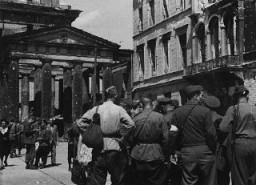
-
Leni Riefenstahl directs a film about the Reich Party Day.
PhotoLeni Riefenstahl, with Adolf Hitler in the background, directs the shooting of a film about the Reich Party Day. Here she is shooting a segment called "Day of the Reich Work Service." Nuremberg, Germany, 1936.
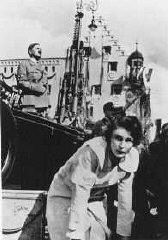
-
Ernest G. Heppner
ID CardErnest was one of three children born to a Jewish family in the commercial city of Breslau, which had one of the largest Jewish communities in Germany. His father, a World War I veteran, owned a factory that made matzah, the unleavened bread used during the Jewish holiday of Passover. Ernest was 12 when Hitler took power in 1933. 1933-39: Ernest often got in trouble at school because people called him names. "Christ-killer" and "your father kills Christian babies for Passover" were common taunts. Many…
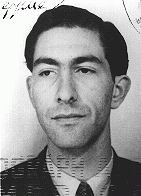
-
A gay couple in Berlin
PhotoPortrait of a gay couple. Berlin, Germany, ca. 1930. Nazi ideology identified a multitude of enemies and led to the systematic persecution and murder of many millions of people, both Jews and non-Jews. The Nazis posed as moral crusaders who wanted to stamp out the "vice" of homosexuality from Germany in order to help win the racial struggle. Once they took power in 1933, the Nazis intensified persecution of German male homosexuals.
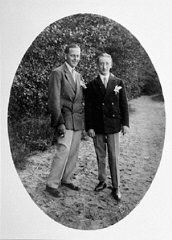
-
Revision of Paragraph 175
Timeline EventJune 28, 1935. On this date, the German government revised Paragraphs 175 and 175a, facilitating the persecution of gay men and men accused of homosexuality.
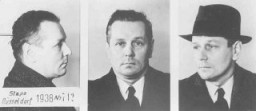
-
The Kusserow family
PhotoThe Kusserow family was active in their region distributing religious literature and teaching Bible study classes in their home. They were Jehovah's Witnesses. Their house was conveniently situated for fellow Jehovah's Witnesses along the tram route connecting the cities of Paderborn and Detmold. For the first three years after the Nazis came to power, the Kusserows endured moderate persecution by local Gestapo agents, who often came to search their home for religious materials. In 1936, Nazi police…

-
Dachau death train
PhotoCorpses lie in one of the open railcars of the Dachau death train. The Dachau death train consisted of nearly forty cars containing the bodies of between two and three thousand prisoners transported to Dachau in the last days of the war. Dachau, Germany, April 29, 1945. This image is among the commonly reproduced and distributed, and often extremely graphic, images of liberation. These photographs provided powerful documentation of the crimes of the Nazi era.

-
Dachau soon after liberation
PhotoSurvivors move around between rows of barracks in the newly liberated Dachau concentration camp. Dachau, Germany, May 1945. This image is among the commonly reproduced and distributed images of liberation. These photographs provided powerful documentation of the crimes of the Nazi era.

-
Demonstrating the operation of the Dachau crematorium
PhotoSurvivors of the Dachau concentration camp demonstrate the operation of the crematorium by pushing a corpse into one of the ovens. Dachau, Germany, April 29–May 10, 1945. This image is among the commonly reproduced and distributed, and often extremely graphic, images of liberation. These photographs provided powerful documentation of the crimes of the Nazi era.
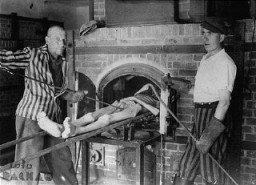
-
Demonstrating the cremation process at Dachau
PhotoSurvivors of the Dachau concentration camp prepare to move a corpse during a demonstration of the cremation process at the camp. Dachau, Germany, April 29–May 10, 1945. This image is among the commonly reproduced and distributed, and often extremely graphic, images of liberation. These photographs provided powerful documentation of the crimes of the Nazi era.
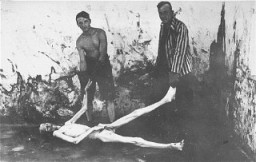
-
Erich Mühsam
PhotoIdentification picture of Erich Mühsam taken in the Oranienburg concentration camp. Mühsam, an anarchist and a pacifist, worked as an editor and writer; he was imprisoned during World War I for opposing the war. Arrested during the massive roundup of Nazi political opponents following the Reichstag fire (February 27, 1933), Mühsam was tortured to death in Oranienburg on July 11, 1934. Oranienburg, Germany, February 3, 1934.
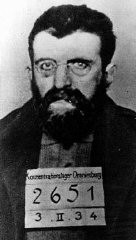
-
War damage in Nuremberg
PhotoAt the time of the International Military Tribunal, the city of Nuremberg reflected the devastation of war, as did much of Europe. This landscape of destruction stands in stark contrast to the Nazi rallies held in Nuremberg only years earlier.
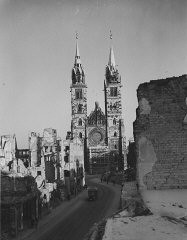
-
Antisemitism
Media EssayThe word antisemitism means prejudice against or hatred of Jews. The Holoca...
-
Jewish deportees from Magdeburg in the Warsaw ghetto
FilmBeginning in 1941, the Germans deported Jews in Germany to the occupied eastern territories. At first, they deported thousands of Jews to ghettos in Poland and the Baltic states. Those deported would share the fate of local Jews. Later, many deportation transports from Germany went directly to the killing centers in occupied Poland. In this footage, a German propaganda unit films recent arrivals from Magdeburg, Germany, in a collection center run by the Jewish council in the Warsaw ghetto. In July 1942,…
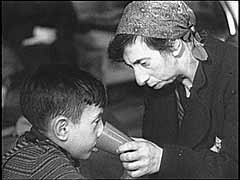
-
Adolf Eichmann
PhotoAdolf Eichmann, SS official in charge of deporting European Jewry. Germany, 1943.

-
Adolf Eichmann
PhotoAdolf Eichmann, SS official in charge of deporting European Jewry. Germany, 1940.

-
SA members post anti-Jewish boycott signs
PhotoAn SA member instructs others where to post anti-Jewish boycott signs on a commercial street in Germany. A German civilian wearing a Nazi armband holds a sheaf of anti-Jewish boycott signs, while SA members paste them on a Jewish-owned business. Most of the signs read, "Germans defend yourselves against Jewish atrocity propaganda/Buy only at German stores." Germany, ca. April 1, 1933.
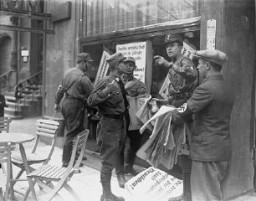
-
Forced labor at the Neuengamme camp
PhotoSS men supervise laborers at construction work. Neuengamme concentration camp, Germany, winter 1943.

-
American Jewish leaders participate in a mass demonstration
PhotoDr. Bernard Deutsch, president of the American Jewish Congress (center) and Rabbi Stephen S. Wise (right) participate in a mass demonstration against Nazi treatment of German Jews. The demonstration took place on the same day as the book burnings in Germany. New York, United States, May 10, 1933.

-
How and why did ordinary people across Europe contribute to the persecution of their Jewish neighbors?
Discussion QuestionMany Europeans witnessed acts of persecution, including violence against Jews and, later, deportations. While few were aware of the full extent of the Nazi "Final Solution," this history poses difficult and fundamental questions about human behavi...
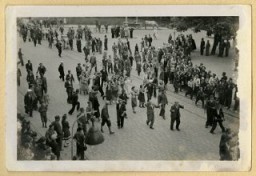
-
Anti-Jewish boycott
PhotoDuring the anti-Jewish boycott, an SA man stands outside a Jewish-owned store with a sign demanding that Germans not buy from Jews. Berlin, Germany, April 1, 1933.
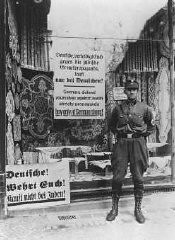
-
Barracks at the Ohrdruf camp
PhotoInterior view of prisoners' barracks at the Ohrdruf subcamp of the Buchenwald concentration camp. This photograph was taken after liberation. Ohrdruf, Germany, April 13, 1945.

-
Adolf Hitler greets Paul von Hindenburg
PhotoAdolf Hitler, the newly appointed chancellor, greets German president Paul von Hindenburg. Berlin, Germany, January 30, 1933.
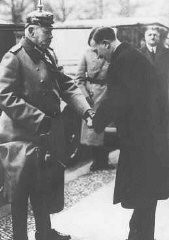
-
Ludwig Beck
PhotoLudwig Beck, one time chief of the Army General Staff. After his resignation in 1938, Beck became the center of the military resistance to Hitler. He was executed in 1944 for his role in the July 1944 attempt to kill Hitler. Germany, date uncertain.
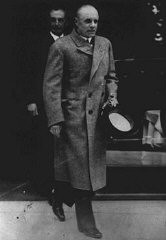
-
Jehovah's Witness Waltraud Kusserow
PhotoWaltraud Kusserow, a Jehovah's Witness, was arrested several times for refusing to make the "Heil Hitler" salute. She spent two and a half years in prison. Germany, after 1945.
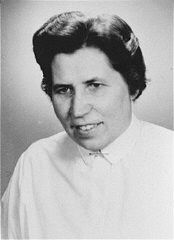
-
Remilitarization of the Rhineland
FilmProvisions of the 1919 Treaty of Versailles forbade Germany (defeated in World War I) to station armed forces in a demilitarized zone in the Rhineland—a region in western Germany bordering France, Belgium, and part of the Netherlands. The treaty stipulated that Allied forces—including US troops—would occupy the region. In a blatant violation of the treaty, on March 7, 1936, Hitler ordered German troops to reoccupy the zone. Hitler gambled that the western powers would not intervene. His action…
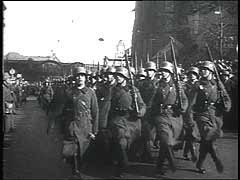
-
German Jews' Passports Declared Invalid
Timeline EventOctober 5, 1938. On this date, the Reich Ministry of the Interior invalidated all German Jews' passports and required them to have a "J" stamped on them.

-
Deportation of Dutch Jews
Timeline EventJuly 15, 1942. On this date, German authorities began the deportation of Dutch Jews from camps in the Netherlands.

-
Liberation of Dachau
FilmThe Dachau concentration camp, northwest of Munich, Germany, was the first regular concentration camp the Nazis established in 1933. About twelve years later, on April 29, 1945, US armed forces liberated the camp. There were about 30,000 starving prisoners in the camp at the time. Here, soldiers of the US Seventh Army document conditions in the camp. They also require German civilians to tour the camp and confront Nazi atrocities.
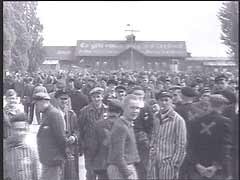
-
Jewish refugees board the St. Louis
PhotoJewish refugees from Nazi Germany board the St. Louis. The ship would be denied entry into Cuba and the United States and forced to return to Europe. Hamburg, Germany, May 13, 1939.
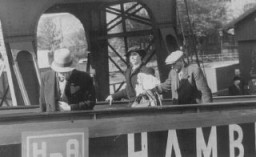
-
Bertolt Brecht
PhotoBertolt Brecht (left), Marxist poet and dramatist, was a staunch opponent of the Nazis. He fled Germany shortly after Hitler's rise to power. Pictured here with his son, Stefan. Germany, 1931.

-
Liberation of Buchenwald
FilmThe US army filmed the weak and emaciated survivors of the Buchenwald concentration camp in Germany to document Nazi crimes against humanity. This film was shot shortly after the liberation of the camp in April 1945.
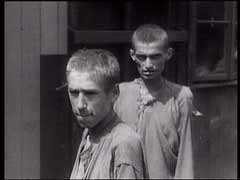
-
Two German Jewish families at a gathering
PhotoTwo German Jewish families at a gathering before the Nazi rise to power. Only two people in this group survived the Holocaust. Germany, 1928.
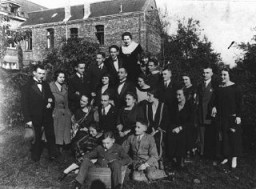
-
US soldiers inspect Hadamar
FilmIn Nazi usage, "euthanasia" referred to the killing of those whom the Nazis deemed "unworthy of life." In 1941 the Hadamar psychiatric clinic served as one of the euthanasia killing centers in Germany. Patients selected by German doctors for euthanasia were transferred to Hadamar or one of the other facilities and were killed in gas chambers. Over 10,000 people were gassed at Hadamar before the Euthanasia Program officially ended in August 1941. Although the program had officially ended, killings continued…
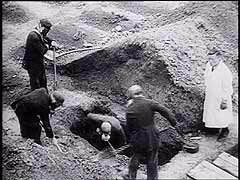
-
Hindenburg Spreads “Stab-in-the-Back” Myth
Timeline EventNovember 18, 1919. On this date, Hindenburg spreads the “stab-in-the-back” myth in a testimony before a committee investigating Germany’s defeat in World War I.
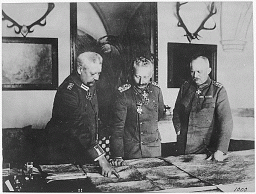
-
Incarcerated for homosexuality
PhotoAn official order incarcerating the accused in the Sachsenhausen concentration camp for the "offence" of homosexuality. Germany, July 1944. The Nazis posed as moral crusaders who wanted to stamp out what they labeled as the "vice" of homosexuality in order to help Germany win the racial struggle. They persecuted homosexuals as part of their so-called moral crusade to racially and culturally purify Germany.

-
Treaty of Versailles Presented to German Delegation
Timeline EventMay 7, 1919. On this date, the Treaty of Versailles was presented to the German delegation. The treaty's "War Guilt Clause" forced Germany to accept responsibility for initiating WWI.

-
Danzig - Photographs
Media EssayFollowing World War I, the Treaty of Versailles (1918) declared Danzig to be a free city administered by Poland and the League of Nations. Germany resented the loss of this largely German city. After invading Poland in September 1939, Nazi Germany annexed Danzig.
-
Geography of the Holocaust
Media EssayThe Holocaust (1933–1945) was the systematic, state-sponsored persecution and murder of six million European Jews by the Nazi German regime and its allies and collaborators. The Holocaust era began in January 1933 when Adolf Hitler and the Nazi Party came to power in Germany. It ended in May 1945, when the Allied Powers defeated Nazi Germany in World War II. The Holocaust was a German initiative that took place throughout German- and Axis-controlled Europe. It affected nearly all of Europe’s Jewish…
-
Poster advertising anti-Jewish boycott
ArtifactThis poster from Munich, Germany, proclaims the April 1, 1933, boycott of Jewish-owned businesses and services offered by Jewish professionals. It calls on all Germans to honor the boycott, which began at 10 a.m. The poster was signed by the radical Nazi antisemite, Julius Streicher, official organizer of the boycott.
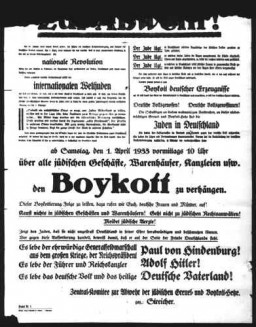
-
Aerial view of Dachau concentration camp
Film[This video is silent] The Dachau concentration camp, northwest of Munich, Germany, was the first regular concentration camp the Nazis established in 1933. About twelve years later, on April 29, 1945, US armed forces liberated the camp. There were some 30,000 starving prisoners in the camp at the time. This footage shows an aerial view of the camp and the entrance gate to the prisoner compound.
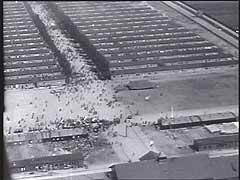
-
US soldiers care for Dachau survivors
FilmThe Dachau concentration camp, northwest of Munich, Germany, was the first regular concentration camp the Nazis established in 1933. About twelve years later, on April 29, 1945, US armed forces liberated the camp. There were some 30,000 starving prisoners in the camp at that time. In this footage, soldiers of the US Seventh Army feed and disinfect survivors of the camp.
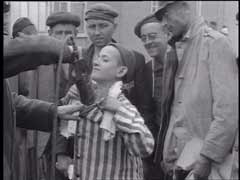
-
German police parade before Adolf Hitler
PhotoParade of German police before Adolf Hitler in front of Hotel Deutsches Haus, at a Nazi Party Congress rally. Nuremberg, Germany, September 10, 1937.
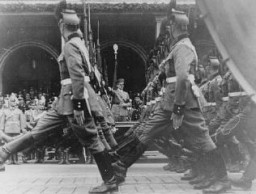
-
Bertolt Brecht
PhotoBertolt Brecht, author of the "Threepenny Opera" and a well-known leftist poet and dramatist, who emigrated from Germany in 1933. In exile, he co-edited an anti-Nazi magazine titled Das Wort. London, Great Britain, 1936.
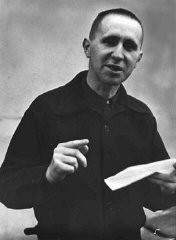
-
Reich Party Day parade
PhotoReich Labor Service battalions parade before Hitler during the Nazi Party Congress. Nuremberg, Germany, September 8, 1937.
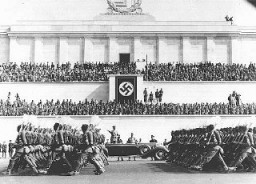
-
Hadamar
Media EssayHadamar was one of six euthanasia killing facilities in the Nazi Euthanasia Program.
-
Dr. Robert Ritter visits a "Gypsy camp"
PhotoDr. Robert Ritter talks to several residents in a Zigeunerlager ("Gypsy camp"). Hamburg, Germany, 1940. During the Nazi era, Dr. Robert Ritter was a leading authority on the racial classification of people pejoratively labeled “Zigeuner” (“Gypsies”). Ritter’s research was in a field called eugenics, or what the Nazis called “racial hygiene.” Ritter worked with a small team of racial hygienists. Among them were Eva Justin and Sophie Ehrhardt. Most of the people whom Ritter studied and…

-
A family interned in a "Gypsy camp"
PhotoA family stands outside of their wagon while interned in a Zigeunerlager ("Gypsy camp"). In the background, children are crowded around Eva Justin. Justin worked for the Center for Research on Racial Hygiene and Demographic Biology. Schleswig-Holstein, Germany, 1938. During the Nazi era, Dr. Robert Ritter was a leading authority on the racial classification of people pejoratively labeled “Zigeuner” (“Gypsies”). Ritter’s research was in a field called eugenics, or what the Nazis called…

-
Munich Agreement
Timeline EventSeptember 29-30, 1938. On this date, Germany, Italy, Great Britain, and France signed the Munich agreement, giving Germany the Sudetenland.
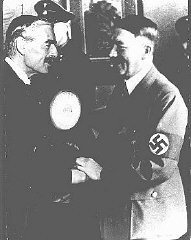
-
Vienna - Photographs
Media EssayGermany annexed Austria in March 1938, bringing approximately 200,000 additional Jews under Nazi rule. The Nazi regime quickly extended anti-Jewish legislation to Austria. At the time, the majority of Austrian Jews...
